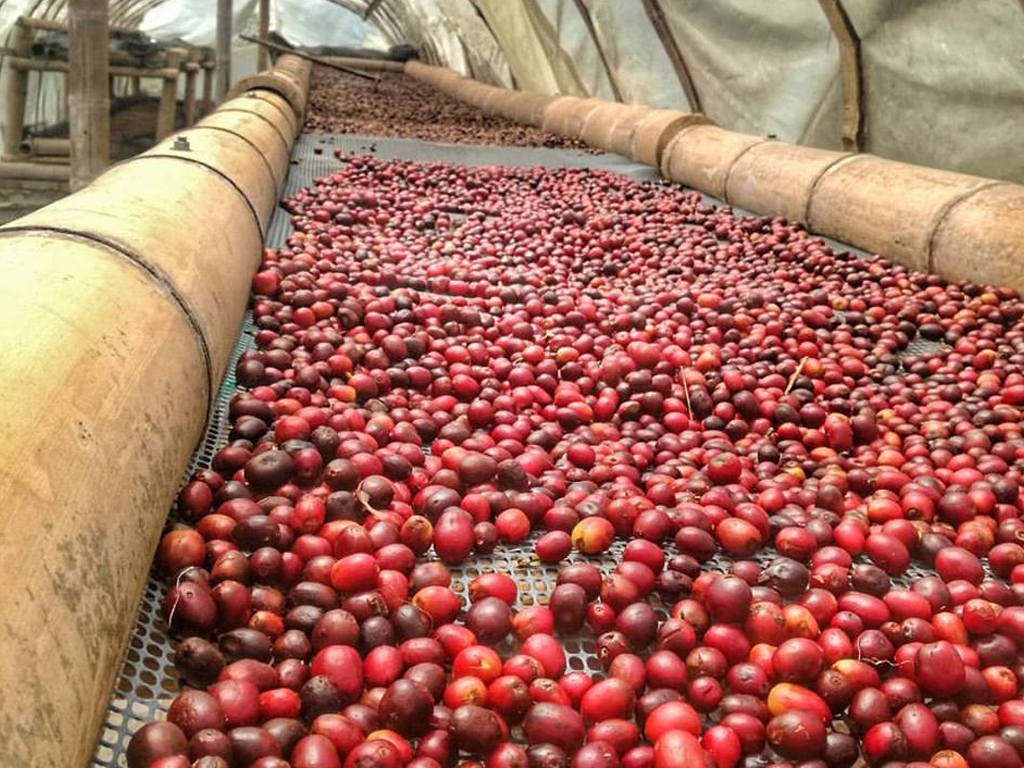Shopping Bag
0
- No products in the cart.

After harvest, the coffee cherries are taken to a wet mill to separate the beans from the flesh and dry the beans so they are safe for storage. Coffee beans start with a moisture content of around 60 per cent, and should be dried to around 11–12 per cent to ensure they do not rot while waiting to be sold and shipped. A wet mill can be anything from a small collection of equipment on an individual farm, to a very large industrialized facility for processing enormous amounts of coffee. The wet mill processes coffee from the cherry stage to the parchment stage, when the bean is dry but still covered with its layer of parchment or pergamino. Most believe that the coffee is pretty well protected by this outer layer, and that it does not really begin to degrade until the coffee is hulled to remove the parchment at the last possible moment before the coffee ships. The term ‘wet milling’ is slightly misleading as some producers use very little, if any, water in the processing methods they use. It does, however, make the distinction between this initial processing and the later stage when the hulling and possible and this is taken into account when a producer chooses which processing method to use. Some processes require more time, investment or natural resources than others, and so it is an important decision for any coffee producer.
DEFINING ‘DEFECT’
The term ‘defect’ is used quite specifically in coffee. It is used to describe individual beans that have developed problems that result in bad flavours. Some defects can be spotted by taking a look at the raw coffee, while others only come to light when the coffee is tasted. A mild defect might be a bean that has been damaged by insects, and this is easy to spot. A more serious problem is a phenolic coffee, where the coffee has a very harsh, metallic, paint-stripper flavour, mixed with notes of sulphur (it is as bad as it sounds). The cause of this defect isn’t well understood yet. Bad processing can also cause defects, including giving the coffee a fermented flavour and an unpleasantly dirty, almost boozy quality. It can also add a taste reminiscent of barnyards and rotten fruit.
Also known as the dry process, this is the oldest method of processing coffee. After harvest, the coffee cherries are spread out in a thin layer to dry in the sun. Some producers spread them out on brick patios, others use special raised drying tables, which allow a better airflow around the cherry, resulting in more even drying. The cherries must be turned regularly to avoid mould, fermentation or rotting taking place. Once the coffee is properly dry, the outer husk of skin and dried fruit are removed mechanically, and the raw coffee is then stored before export.
The natural process itself adds certain flavours to the coffee, sometimes positive but often quite unpleasant. However, if there is no access to water this may be the only process open to the producer and is therefore common in places like Ethiopia, and also parts of Brazil. Worldwide, the dry method is generally deemed only suitable for very low-quality or unripe coffee, and the bulk of coffee produced this way is processed as cheaply as possible as it usually ends up in the domestic market and has very little value. It seems counterintuitive that a producer would invest in the drying tables necessary for the little return on offer.
However, there are those who choose this method to process high-quality coffee, and they often find the process to be more expensive due to the additional labour involved in the attentive, careful drying of the cherries. This process remains quite traditional in places, and there is certainly demand for the cup qualities that a carefully processed lot can have. The process will often add fruit flavours to the coffee, regardless of variety and terroir. These are usually described as hints of blueberry, strawberry or tropical fruit, but sometimes with negative terms like barnyard, wild, ferment and manure.
High-quality naturals polarize those who work in coffee. Many see value in coffees that taste spectacularly fruity, and believe they are extremely useful for showcasing the possibilities of flavour that coffee has to offer. Others find the wild flavours unpleasant, or have concerns about buyers encouraging producers to process more of their coffee through the natural process. With such an unpredictable process, a high-quality lot could be damaged irreparably and significantly reduce the producer’s income.



Free Shipping On All Orders $200+ |
